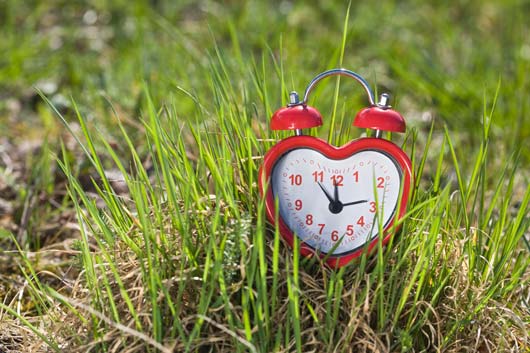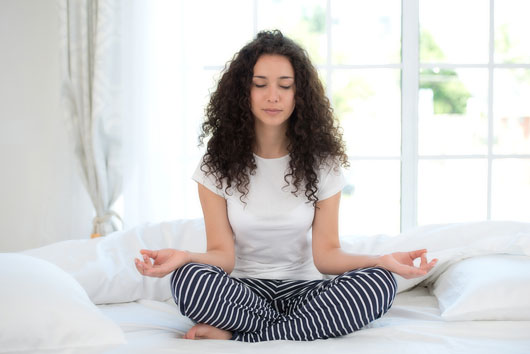
It’s that time of year again, time to spring forward—when days get longer and (thankfully) the winter chill starts to make its grand exit. That’s right, it’s Daylight Savings Time! In case you forgot that clever phrase “fall back, spring forward,” Sunday, March 8th is the day when you set your clocks forward one hour. So 2am becomes 3am in a split second. There’s good news and bad news. Let’s do the bad news first: you will lose one hour of sleep. Crap. But wait, the good news is REALLY good news! You will gain one hour of sunlight every single day until November (when we set our clocks back once again). After a brutal winter of dark, cold days, we’ll take it.
So what is Daylight Savings Time (DST) all about? It began during World War I in Germany in an effort to conserve energy. As ABC News reports, “The goal was to take advantage of the daylight hours in spring by moving an additional hour of daylight from the morning to the evening and not letting people sleep through the first few hours of sunshine.” DST is observed in 48 states in America, not including Arizona and Hawaii (where their climate and daylight hours don’t require the same time shift between seasons). So while we all may be tired for a couple days, we receive the gift of an extra hour of daylight for about 8 months. Here are 8 ways to help you spring forward, cope with the time change and to maximize Daylight Savings Time every day.
1. Take it easy Saturday night
Because you will be losing an hour of sleep Sunday morning, it’s a good idea to go to bed a little earlier Saturday night. We know, easier said that done. After all, it is Saturday. Your head says go home and rest, but your wine glass says have one more…it’s the weekend! Keep in mind that at 2am, regardless of where you are or how long ago you fell asleep, your clocks will reset to one hour ahead, making your morning routine tough if you’re sleep-deprived. Take it easy; try to bump your bedtime up so you can catch up on some zzz’s in preparation for the time shift ahead.
Read Related: Daylight Saving Time Could Kill You: How to Prevent It!

2. Prep early and skip the afternoon latte
Going to bed earlier can be tough, especially when your mind is still working and you’re 100% alert and awake. But on Daylight Savings Time, it’s important to start your wind-down routine early so you are ready for rest at a reasonable hour. After all, you’ll be missing one hour of sleep, and that one hour can make a big difference. As CBS reports, according to Dr. Yoseph Krespi, Director of the Center for Sleep Disorders at Lenox Hill Hospital in New York, skipping one hour of sleep “can change the sleep cycle and disrupt the opportunity to get a restful sleep.” Prep early—skip your afternoon coffee and limit caffeine intake.

3. Wake up at your normal time
You get an extra hour of sunlight, but that perk goes away if you sleep through the first few hours of your day. We know you’ll be a bit pooped when the alarm goes off, but try to wake up at your normally scheduled time, despite the time change. You will get a jumpstart on your day and it will help your body reset back to your normal schedule.

4. Get moving with a morning workout
The best way to wake your body and your mind up in the morning isn’t coffee (though we do love our morning cup of Joe). Exercise gets your blood flowing and activates all your muscles (including your brain) so you are geared up for the day ahead. When you wake up, regardless of how sleepy you may feel, get moving. Whether you go for a jog, a swim, take a cycling class or practice Pilates, get active and welcome the new day with a major dose of energy.

5. Take a stroll before bed
As you spring forward, you’ll see that it will stay light one hour later than before we shifted our clocks, which means you get a whole extra hour at night to enjoy being outside. Take your dog for a long walk, take your kids for a stroll or just step outside for some fresh air and last minute sunlight before night falls. Not only will you tire yourself out before your bedtime routine sets in, but you’ll appreciate some free time (read: not at work) outside before the day is done.

6. Meditate
If you’ve always wanted to try meditation but you never had the time, well now you have no excuse. You have an extra hour of daylight (aka, usable time) each day, now is your chance. Whether you choose to meditate first thing in the morning or at the end of your workday, meditation has been shown to reduce stress, improve sleep, lower blood pressure and relax the mind and body. The benefits are undeniable, and now’s the perfect time of year to commit to get started.

7. Take your kids to the park
Extra daylight = extra time to exhaust your kids before bed. Take them to the park for an end-of-day play session…let them run around, climb the monkey bars, kick a soccer ball, and just go nuts. They will burn off extra energy and bedtime will be that much better for everyone involved. Plus you can bond as you enjoy the final hours of daylight outside together.

6. Gradually adjust your (and your kids’) sleep schedule
The time change can be an adjustment for anyone, especially for little kids and babies. Don’t expect them to settle in with Daylight Savings Time right away. It might time a bit of time to adjust to the new daylight hours and the fact that the sun could still be setting when they hit the sack. Try using blackout shades to set the nighttime mood, and maintain a stable nighttime routine to help them wind down at the end of the day. And instead of sticking strictly to their original bedtime, you might want to gradually adjust their bed time (and yours) by 15 minutes each night until you all settle back in to your old routine.











